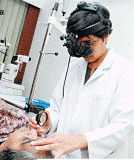Health Topics
-
Healthy Living
-
|
| |
| Diabetes and the Eye |
| Dr Mallika Goyal
|
| |
 |
People with untreated diabetes are about 25 times more at risk for blindness than the general population |
|
| |
Diabetes can affect the eyes in the following ways
- Diabetic retinopathy, the most common ocular complication of diabetes
- Glaucoma, not caused by diabetes, but seen more commonly in diabetics than in others
- Early-onset cataract
|
|
|
|
Diabetic Retinopathy
Diabetic retinopathy is a specific complication of diabetes, and is the most common cause of blindness in individuals between the age of 20 and 65 years.
After 10 years of the disease, 90 per cent of patients with childhood-onset diabetes and 65 per cent of patients with late-onset diabetes will develop retinopathy. However, even people with advanced retinopathy are often unaware they have these severe eye changes, as vision continues to be normal till almost the end! Therefore it’s important to catch it early.
Treatment is effective and relatively painless.
|
| |
Clinical Features
The typical features of retinopathy are retinal hemorrhages, retinal microaneurysms and hard exudates. The clinical picture can be graded as follows:
I. Non-proliferative Diabetic Retinopathy
II. Proliferative Diabetic Retinopathy
III. End-Stage Diabetic Eye Disease
IV. Retinal Detachment, Neovascular Glaucoma |
| |
Risk Factors for the Development and Progression of Diabetic Retinopathy
I. Duration of diabetes
- After 20 years of diabetes, nearly all patients with childhood diabetes, and over 60 per cent of patients with late-onset diabetes, have some degree of retinopathy.
- Years of diabetes before puberty do not count.
- Age: Incidence increases sharply after age 15 years.
II. Blood glucose control
- Tight control of blood sugar levels slows the onset and progression of retinopathy, and lessens the need for laser surgery for severe retinopathy.
- Type of Diabetes: Prevalence of retinopathy is higher in Insulin-dependent diabetics (40 per cent) than in Non-insulin dependent diabetics (20 per cent).
III. Kidney involvement
Protein in urine, elevated blood urea nitrogen and blood creatinine are excellent predictors of the presence of retinopathy.
IV. Systemic hypertension
V. Pregnancy
- Women beginning a pregnancy without retinopathy have a 10 per cent risk of developing background retinopathy and four per cent progress in severity.
- Those with untreated proliferative retinopathy at the onset, frequently do poorly unless they are treated with retinal photocoagulation.
- Women with previously treated proliferative retinopathy usually do not worsen during the pregnancy.
VI. Smoking
Smoking neutralizes the hemoglobin in the blood, aggravating anemia.
VII. Hyperlipidemias (raised lipids in blood)
Hyperlipids (excessive fat in the bloodstream) impairs blood circulation.
VIII. Anemia
IX. Heredity
These factors reduce blood availability to the eye. |
|
|
| |
|
|
| |
|